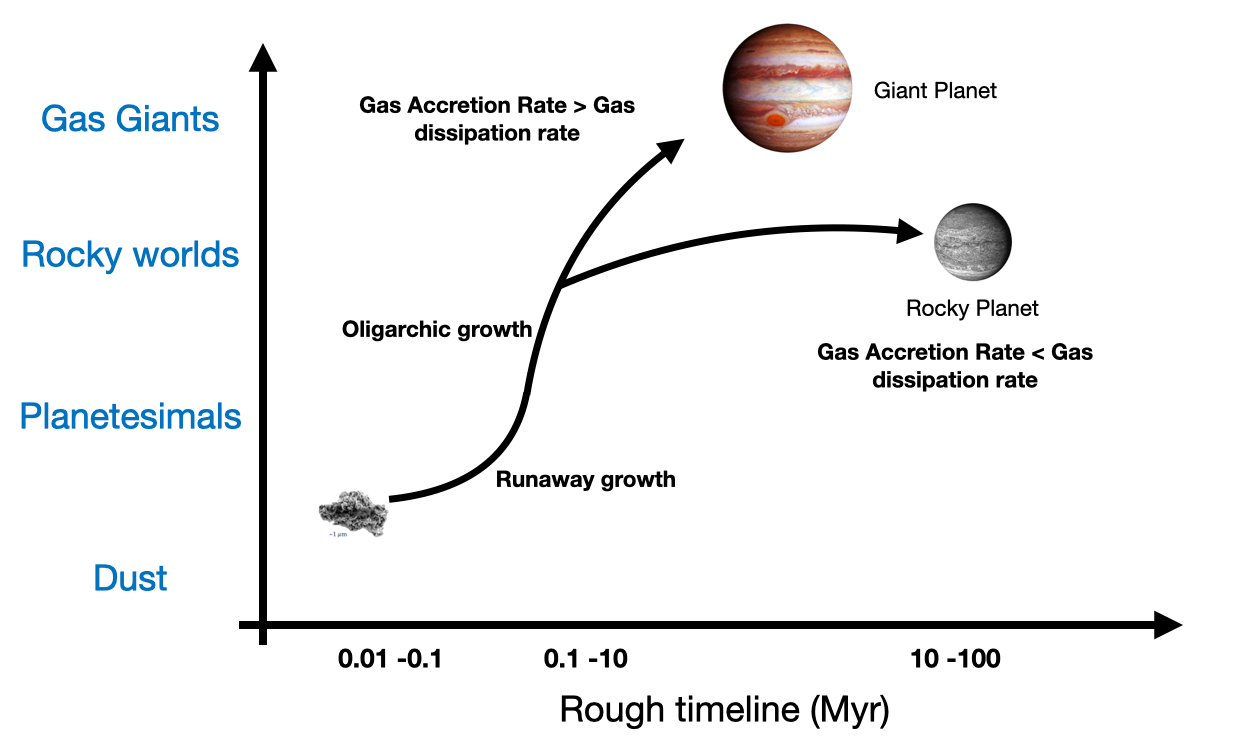Most stars hosting giant planets are younger compared to stars hosting smaller planets, shows a study that traced the abundance of various elements in stars. This result answers long-standing questions regarding timeline of small and giant planet formation.
Since stars and planets are formed from the same molecular cloud or from a large interstellar cloud of gas and dust, many of the fundamental properties of stars are intrinsically linked to the kinds of planets that can form around them. The ejection of new material from stellar explosions constantly replenishes the interstellar medium. Previous research has revealed that high-mass giant planets (like Jupiter or Saturn) are usually found around stars with higher iron contents [Fe/H]. However, the stars hosting low-mass planets (like Earth or Neptune) showed no such preference, indicating that the metal-rich environment is not so essential for forming low-mass planets but crucial for forming gas giants.
For a Jupiter-like planet to form, a planetary core of about 10 earth-mass has to be formed first, and that too rapidly, within a few million years. The metal-rich protoplanetary material helps build the cores faster. The heavy core can then accrete the gas to form the giant planet. In a competing process, radiation from the central star tries to expel the gas from the protoplanetary disc. To counter this, the core has to be built rather quickly before the gas dissipates. Such a core-accretion process successfully explains the formation of giant planets. Though some research has been done correlating age of stars to the size of the planets its hosts, the relation between chemical evolution of stars and the size of the planets has not been explored adequately.
A study by scientists of the Indian Institute of Astronomy (IIA) and Tata Institute of Fundamental Research (TIFR) analysed the galactic chemical evolution of stars hosting exoplanets and found that stars of high mass planets were usually young ones and had chemical composition that indicated its young age. The study has linked the role of chemical composition of the host star to the type of planet it can host.
While prior studies have analyzed the role of iron in planet formation, this study published recently in the Astronomical Journal was the first one which linked the mass of exoplanets to the chemical evolution of the galaxy. The scientists from by scientists from the Indian Institute of Astrophysics, Bangalore, and the Tata Institute of Fundamental Research, Mumbai, correlated the abundance patterns of 16 elements (including alpha and iron-peak elements) with mass.
They used a sizable sample of more than 900 exoplanet-hosting stars from various radial velocity and transit surveys.
The authors found that the alpha(elements such as Mg, Si, Ca, etc.) to iron ratio was higher for stars with low-mass planets and lower for stars with high-mass planets. The study concluded that since the alpha and iron-peak elements were created and released into the interstellar medium at different time scales, the low-mass planetary systems must have started forming early in the galaxy, while giant planets are mostly formed around Iron-rich stars that are relatively young.
This is the direct consequence of how the interstellar medium was enriched during the Milky Way’s chemical evolution and how the increasing metal content (particularly iron and iron-peak elements) in later stages of evolution facilitated the formation of the giant planets.
"Our independent age analysis also shows that the host stars of massive gas giant planets are indeed younger than the stars hosting low-mass planets,” said The lead author of the paper and a Ph.D. student at IIA, Swastik Chowbay.
“There are multiple evidences to conclude that there is a clear time lag in the initial onset for the formation of small and giant planets,” added Ravinder Banyal from IIA.
The others who participated in the study included T. Sivarani, S. P. Rajaguru, and A.Unni from IIA and M.Narang, P. Manoj, and B. Banerjee from TIFR.
Publication Link: https://iopscience.iop.org/article/10.3847/1538-3881/ac756a

Figure : Schematic representation of planet formation in the context of galactic chemical evolution.






























